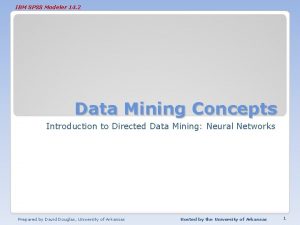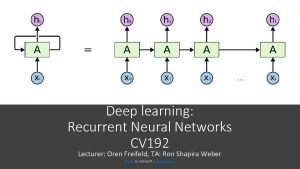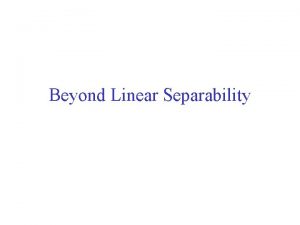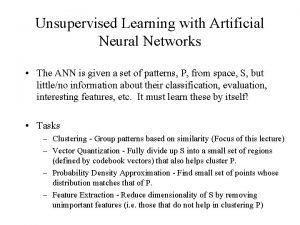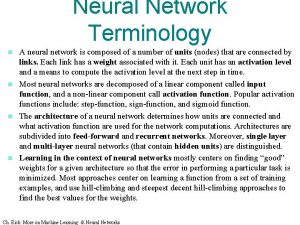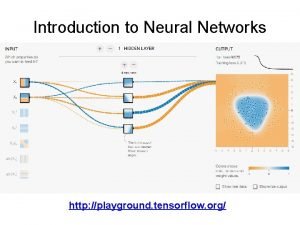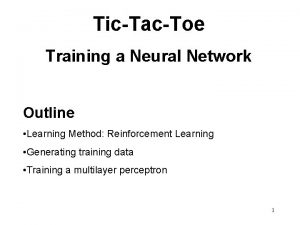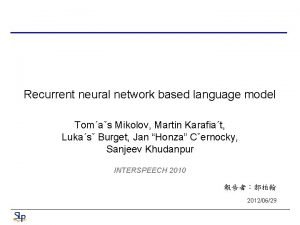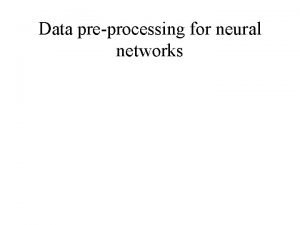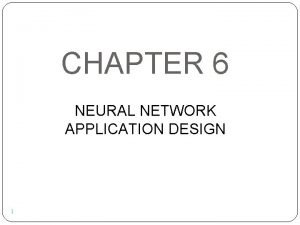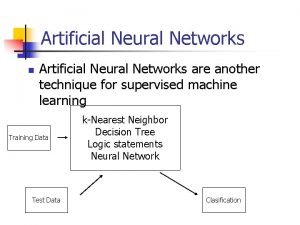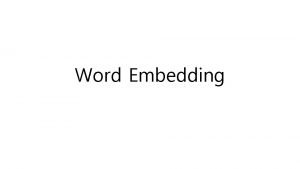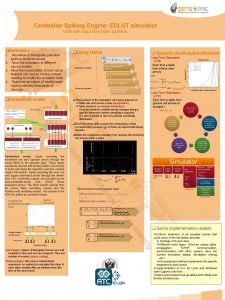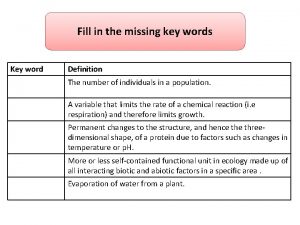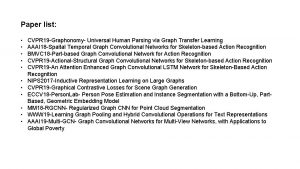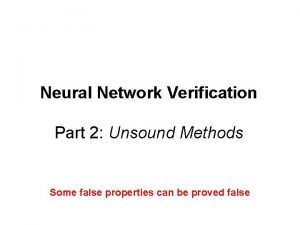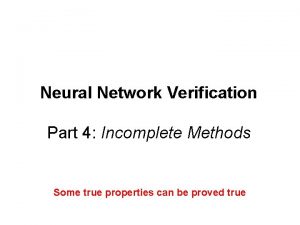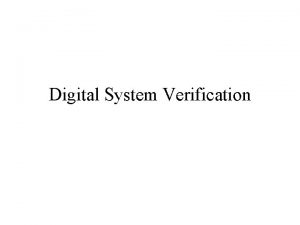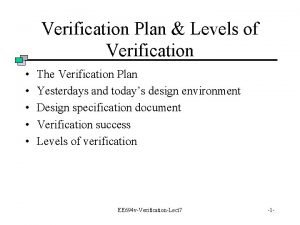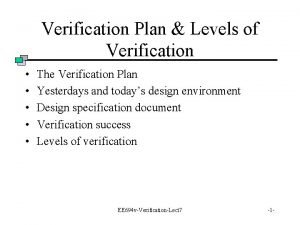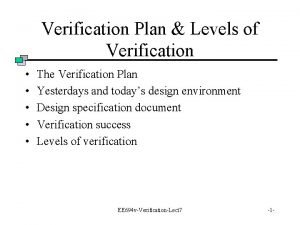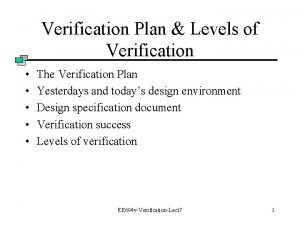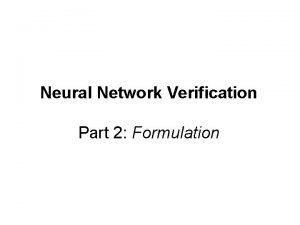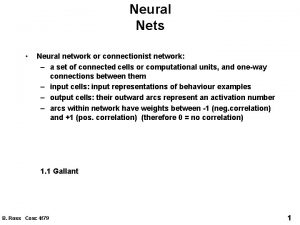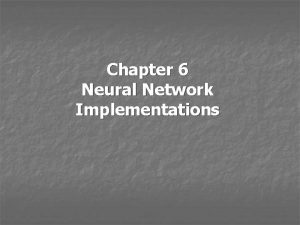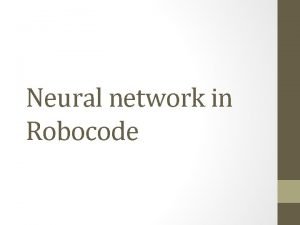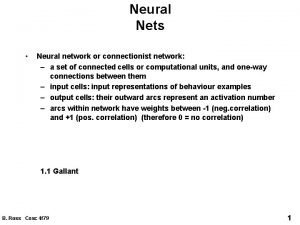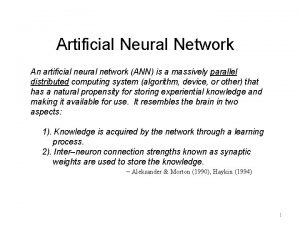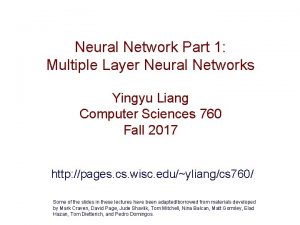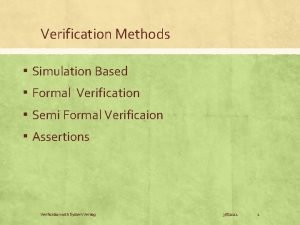Neural Network Verification Part 5 Complete Methods Neural





















![Relaxation Post ain ∈ [l, u] aout = max{ain, 0} aout l Replace with Relaxation Post ain ∈ [l, u] aout = max{ain, 0} aout l Replace with](https://slidetodoc.com/presentation_image/eade80a280be59754d47da83c6b93b32/image-22.jpg)













![Relaxation Post ain ∈ [l, u] aout = max{ain, 0} aout l Replace with Relaxation Post ain ∈ [l, u] aout = max{ain, 0} aout l Replace with](https://slidetodoc.com/presentation_image/eade80a280be59754d47da83c6b93b32/image-36.jpg)













![Relaxation Post ain ∈ [l, u] aout = max{ain, 0} aout l Replace with Relaxation Post ain ∈ [l, u] aout = max{ain, 0} aout l Replace with](https://slidetodoc.com/presentation_image/eade80a280be59754d47da83c6b93b32/image-50.jpg)














- Slides: 64

Neural Network Verification Part 5: Complete Methods

Neural Network Post. Verification Neural network f Scalar output z = f(x) E. g. in binary classification, z = s(y*; x) – s(y; x) for y ≠ y* Property: f(x) > 0 for all x ∈ X Complete methods try to disprove the property

Branch-and-Bound Post Find v ∈ V such that h(v) ≤ 0 V V 1 BRANCH: Split the feasible set 2 or more usually disjoint subsets V 2

Branch-and-Bound Post Find v ∈ V such that h(v) ≤ 0 V 2 3 V 1 V 2 BOUND: Compute upper bounds for each branch h(v) for any feasible v (unsound methods)

Branch-and-Bound Post Find v ∈ V such that h(v) ≤ 0 V 2 -3 V 1 3 -2 V 2 BOUND: Compute lower bounds for each branch Convex relaxations (incomplete methods)

Branch-and-Bound Post Find v ∈ V such that h(v) ≤ 0 V 2 -3 V 1 3 -2 V 2 PRUNE: Any lower bounds greater than 0? NO

Branch-and-Bound Post Find v ∈ V such that h(v) ≤ 0 V 2 -3 V 1 SELECT: Choose a subproblem Say, we choose V 2 3 -2 V 2

Branch-and-Bound Post Find v ∈ V such that h(v) ≤ 0 V 2 -3 3 -2 V 1 V 21 BRANCH: Split the feasible set V 22

Branch-and-Bound Post Find v ∈ V such that h(v) ≤ 0 V 2 -3 3 -2 V 1 V 2 2 1 V 22 BOUND: Compute upper bounds Upper bounds of children are smaller than the parent

Branch-and-Bound Post Find v ∈ V such that h(v) ≤ 0 V 2 -3 3 -2 V 1 V 2 2 1 1 V 22 -1 BOUND: Compute lower bounds Lower bounds of children are greater than the parent

Branch-and-Bound Post Find v ∈ V such that h(v) ≤ 0 V 2 -3 3 -2 V 1 V 2 2 1 1 V 22 PRUNE: Any lower bounds greater than 0? YES -1

Branch-and-Bound Post Find v ∈ V such that h(v) ≤ 0 V 2 -3 3 -2 V 1 V 2 2 1 1 V 22 PRUNE: Any lower bounds greater than 0? YES -1

Branch-and-Bound Post Find v ∈ V such that h(v) ≤ 0 V 2 -3 3 -2 V 1 V 2 2 SELECT: Choose a subproblem Say, we choose V 1 1 1 V 22 -1

Branch-and-Bound Post Find v ∈ V such that h(v) ≤ 0 V 2 -3 3 -2 V 1 V 2 2 V 11 V 12 BRANCH: Split the feasible set 1 1 V 22 -1

Termination Post– Case I Find v ∈ V such that h(v) ≤ 0 V 2 -3 3 -2 V 1 V 2 2 V 11 V 12 1 1 V 22 We find a counter-example An upper bound that is less than 0 -1

Termination Post– Case II Find v ∈ V such that h(v) ≤ 0 V 2 -3 3 -2 V 1 V 2 2 V 11 V 12 1 1 V 22 -1 We prove there does not exist v ∈ V s. t. h(v) ≤ 0 All leaf nodes have lower bound > 0

Unified. Post Framework All proposed complete methods are branch-and-bound Choice of branching Choice of bounding Choice of selecting (critical for false properties)

Outline • Reluplex • Planet • Input Domain Branch-and-Bound • Result Katz, Barrett, Dill, Julian and Kochendefer, 2017

Example Post -2 ≤ x 1 ≤ 2 -2 ≤ x 2 ≤ 2 a 1 [-2, 2] x 1 ain = x 1 + x 2 -1 1 z [-2, 2] 1 x 2 -1 -1 b Prove that z > -5 bin = x 1 - x 2 aout = max{ain, 0} bout = max{bin, 0} z = - aout - bout z ≤ -5

Bounding Post x 1 x 2 ain aout bin bout z -2 ≤ x 1 ≤ 2 0 0 0 0 -2 ≤ x 2 ≤ 2 ain = x 1 + x 2 bin = x 1 - x 2 aout = max{ain, 0} bout = max{bin, 0} z = - aout - bout Infeasible z ≤ -5

Bounding Post x 1 x 2 ain aout bin bout z -2 ≤ x 1 ≤ 2 0 0 0 0 -2 ≤ x 2 ≤ 2 ain = x 1 + x 2 bin = x 1 - x 2 aout = max{ain, 0} bout = max{bin, 0} z = - aout - bout Relax all non-linearities z ≤ -5
![Relaxation Post ain l u aout maxain 0 aout l Replace with Relaxation Post ain ∈ [l, u] aout = max{ain, 0} aout l Replace with](https://slidetodoc.com/presentation_image/eade80a280be59754d47da83c6b93b32/image-22.jpg)
Relaxation Post ain ∈ [l, u] aout = max{ain, 0} aout l Replace with convex superset u ain

Bounding Post x 1 x 2 ain aout bin bout z -2 ≤ x 1 ≤ 2 0 0 0 0 -2 ≤ x 2 ≤ 2 ain = x 1 + x 2 bin = x 1 - x 2 aout ≥ ain, aout ≥ 0, aout ≤ 4 bout ≥ bin, bout ≥ 0, bout ≤ 4 z = - aout - bout Relax all non-linearities z ≤ -5

Bounding Post x 1 x 2 ain aout bin bout z -2 ≤ x 1 ≤ 2 0 0 0 1 0 4 -5 -2 ≤ x 2 ≤ 2 ain = x 1 + x 2 bin = x 1 - x 2 aout ≥ ain, aout ≥ 0, aout ≤ 4 bout ≥ bin, bout ≥ 0, bout ≤ 4 z = - aout - bout z ≤ -5

Bounding Post x 1 x 2 ain aout bin bout z -2 ≤ x 1 ≤ 2 0 0 0 1 0 4 -5 -2 ≤ x 2 ≤ 2 ain = x 1 + x 2 bin = x 1 - x 2 aout = max{ain, 0} bout = max{bin, 0} z = - aout - bout Infeasible z ≤ -5

Bounding Post x 1 x 2 ain aout bin bout z -2 ≤ x 1 ≤ 2 0 0 0 1 0 4 -5 -2 ≤ x 2 ≤ 2 ain = x 1 + x 2 bin = x 1 - x 2 aout = max{ain, 0} bout = max{bin, 0} Fix a non-linearity (say b) Relax other non-linearities z = - aout - bout z ≤ -5

Bounding Post x 1 x 2 ain aout bin bout z -2 ≤ x 1 ≤ 2 0 0 0 1 0 4 -5 -2 ≤ x 2 ≤ 2 ain = x 1 + x 2 bin = x 1 - x 2 aout ≥ ain, aout ≥ 0, aout ≤ 4 bout = bin Fix a non-linearity (say b) Relax other non-linearities z = - aout - bout z ≤ -5

Bounding Post x 1 x 2 ain aout bin bout z -2 ≤ x 1 ≤ 2 2 -2 0 1 4 4 -5 -2 ≤ x 2 ≤ 2 ain = x 1 + x 2 bin = x 1 - x 2 aout ≥ ain, aout ≥ 0, aout ≤ 4 bout = bin z = - aout - bout z ≤ -5

Bounding Post x 1 x 2 ain aout bin bout z -2 ≤ x 1 ≤ 2 2 -2 0 1 4 4 -5 -2 ≤ x 2 ≤ 2 Repeat ain = x 1 + x 2 Try to fix some non-linearities bin = x 1 - x 2 Relax other non-linearities aout = max{ain, 0} bout = max{bin, 0} z = - aout - bout After some attempts, branch z ≤ -5

Branching Post -2 ≤ x 1 ≤ 2 -2 ≤ x 2 ≤ 2 ain = x 1 + x 2 Choose a non-linearity that is fixed many times bin = x 1 - x 2 aout = max{ain, 0} bout = max{bin, 0} z = - aout - bout z ≤ -5

Branching Post -2 ≤ x 1 ≤ 2 -2 ≤ x 2 ≤ 2 ain = x 1 + x 2 Choose a non-linearity that is fixed many times bin = x 1 - x 2 aout = max{ain, 0} Split into two bout = max{bin, 0} z = - aout - bout z ≤ -5

Branching Post -2 ≤ x 1 ≤ 2 -2 ≤ x 2 ≤ 2 ain = x 1 + x 2 bin = x 1 - x 2 aout = 0 aout = ain bout = max{bin, 0} z = - aout - bout z ≤ -5

Outline • Reluplex • Planet • Input Domain Branch-and-Bound • Result Ehlers, 2017

Example Post -2 ≤ x 1 ≤ 2 -2 ≤ x 2 ≤ 2 a 1 [-2, 2] x 1 ain = x 1 + x 2 -1 1 z [-2, 2] 1 x 2 -1 -1 b Prove that z > -5 bin = x 1 - x 2 aout = max{ain, 0} bout = max{bin, 0} z = - aout - bout z ≤ -5

Bounding Post -2 ≤ x 1 ≤ 2 -2 ≤ x 2 ≤ 2 ain = x 1 + x 2 bin = x 1 - x 2 aout = max{ain, 0} bout = max{bin, 0} z = - aout - bout Relax all non-linearities z ≤ -5
![Relaxation Post ain l u aout maxain 0 aout l Replace with Relaxation Post ain ∈ [l, u] aout = max{ain, 0} aout l Replace with](https://slidetodoc.com/presentation_image/eade80a280be59754d47da83c6b93b32/image-36.jpg)
Relaxation Post ain ∈ [l, u] aout = max{ain, 0} aout l Replace with convex superset u ain

Bounding Post -2 ≤ x 1 ≤ 2 -2 ≤ x 2 ≤ 2 ain = x 1 + x 2 bin = x 1 - x 2 aout ≥ ain, aout ≥ 0, aout ≤ ain/2+2 bout ≥ bin, bout ≥ 0, bout ≤ bin/2+2 z = - aout - bout z ≤ -5

Branching Post aout = 0 bout = bin -2 ≤ x 1 ≤ 2 aout = ain bout = 0 bout = bin -2 ≤ x 2 ≤ 2 ain = x 1 + x 2 bin = x 1 - x 2 aout ≥ ain, aout ≥ 0, aout ≤ ain/2+2 bout ≥ bin, bout ≥ 0, bout ≤ bin/2+2 z = - aout - bout z ≤ -5

Branching Post aout = 0 bout = 0 -2 ≤ x 1 ≤ 2 aout = ain bout = bin bout = 0 bout = bin -2 ≤ x 2 ≤ 2 ain = x 1 + x 2 bin = x 1 - x 2 aout ≥ ain, aout ≥ 0, aout ≤ ain/2+2 bout ≥ bin, bout ≥ 0, bout ≤ bin/2+2 z = - aout - bout Feasible? NO z ≤ -5

Branching Post aout = 0 bout = bin -2 ≤ x 1 ≤ 2 aout = ain bout = 0 bout = bin -2 ≤ x 2 ≤ 2 ain = x 1 + x 2 bin = x 1 - x 2 aout ≥ ain, aout ≥ 0, aout ≤ ain/2+2 bout ≥ bin, bout ≥ 0, bout ≤ bin/2+2 z = - aout - bout Prune away z ≤ -5

Branching Post aout = 0 bout = 0 -2 ≤ x 1 ≤ 2 aout = ain bout = bin bout = 0 bout = bin -2 ≤ x 2 ≤ 2 ain = x 1 + x 2 bin = x 1 - x 2 aout ≥ ain, aout ≥ 0, aout ≤ ain/2+2 bout ≥ bin, bout ≥ 0, bout ≤ bin/2+2 Feasible? YES x 1 = 2, x 2 = 2, aout = 4, bout = 2 z = - aout - bout z ≤ -5

Branching Post aout = 0 bout = 0 -2 ≤ x 1 ≤ 2 aout = ain bout = bin bout = 0 bout = bin -2 ≤ x 2 ≤ 2 ain = x 1 + x 2 bin = x 1 - x 2 aout ≥ ain, aout ≥ 0, aout ≤ ain/2+2 bout ≥ bin, bout ≥ 0, bout ≤ bin/2+2 z = - aout - bout Feasible? NO z ≤ -5

Branching Post aout = 0 bout = bin -2 ≤ x 1 ≤ 2 aout = ain bout = 0 bout = bin -2 ≤ x 2 ≤ 2 ain = x 1 + x 2 bin = x 1 - x 2 aout ≥ ain, aout ≥ 0, aout ≤ ain/2+2 bout ≥ bin, bout ≥ 0, bout ≤ bin/2+2 z = - aout - bout Prune away z ≤ -5

Branching Post aout = 0 bout = 0 -2 ≤ x 1 ≤ 2 aout = ain bout = bin bout = 0 bout = bin -2 ≤ x 2 ≤ 2 ain = x 1 + x 2 bin = x 1 - x 2 aout ≥ ain, aout ≥ 0, aout ≤ ain/2+2 bout ≥ bin, bout ≥ 0, bout ≤ bin/2+2 z = - aout - bout Feasible? NO z ≤ -5

Branching Post aout = 0 bout = bin -2 ≤ x 1 ≤ 2 aout = ain bout = 0 bout = bin -2 ≤ x 2 ≤ 2 ain = x 1 + x 2 bin = x 1 - x 2 aout ≥ ain, aout ≥ 0, aout ≤ ain/2+2 bout ≥ bin, bout ≥ 0, bout ≤ bin/2+2 z = - aout - bout Prune away z ≤ -5

Branching Post aout = 0 bout = bin -2 ≤ x 1 ≤ 2 aout = ain bout = 0 bout = bin -2 ≤ x 2 ≤ 2 ain = x 1 + x 2 bin = x 1 - x 2 aout ≥ ain, aout ≥ 0, aout ≤ ain/2+2 bout ≥ bin, bout ≥ 0, bout ≤ bin/2+2 z = - aout - bout Property must be true z ≤ -5

Outline • Reluplex • Planet • Input Domain Branch-and-Bound • Result Bunel, Turkaslan, Torr, Kohli and Kumar, 2018

Example Post -2 ≤ x 1 ≤ 2 -2 ≤ x 2 ≤ 2 a 1 [-2, 2] x 1 ain = x 1 + x 2 -1 1 z [-2, 2] 1 x 2 -1 -1 b Prove that z > -5 bin = x 1 - x 2 aout = max{ain, 0} bout = max{bin, 0} z = - aout - bout

Bounding Post -2 ≤ x 1 ≤ 2 -2 ≤ x 2 ≤ 2 ain = x 1 + x 2 bin = x 1 - x 2 aout = max{ain, 0} bout = max{bin, 0} z = - aout - bout Relax all non-linearities
![Relaxation Post ain l u aout maxain 0 aout l Replace with Relaxation Post ain ∈ [l, u] aout = max{ain, 0} aout l Replace with](https://slidetodoc.com/presentation_image/eade80a280be59754d47da83c6b93b32/image-50.jpg)
Relaxation Post ain ∈ [l, u] aout = max{ain, 0} aout l Replace with convex superset u ain

Bounding Post x 2 -2 ≤ x 1 ≤ 2 x 1 -2 ≤ x 2 ≤ 2 ain = x 1 + x 2 bin = x 1 - x 2 aout ≥ ain, aout ≥ 0, aout ≤ ain/2+2 bout ≥ bin, bout ≥ 0, bout ≤ bin/2+2 z = - aout - bout zmin = -6 min z

Bounding Post x 2 -2 ≤ x 1 ≤ 2 x 1 -2 ≤ x 2 ≤ 2 ain = x 1 + x 2 bin = x 1 - x 2 aout ≥ ain, aout ≥ 0, aout ≤ ain/2+2 bout ≥ bin, bout ≥ 0, bout ≤ bin/2+2 z = - aout - bout min z

Bounding Post x 2 -2 ≤ x 1 ≤ 0 x 1 -2 ≤ x 2 ≤ 2 ain = x 1 + x 2 bin = x 1 - x 2 aout ≥ ain, aout ≥ 0, aout ≤ ain/3+4/3 bout ≥ bin, bout ≥ 0, bout ≤ bin/3+4/3 Prune away z = - aout - bout zmin = -2. 66 min z

Bounding Post x 2 0 ≤ x 1 ≤ 2 x 1 -2 ≤ x 2 ≤ 2 ain = x 1 + x 2 bin = x 1 - x 2 aout ≥ ain, aout ≥ 0, aout ≤ 2 ain/3+4/3 bout ≥ bin, bout ≥ 0, bout ≤ 2 bin/3+4/3 z = - aout - bout zmin = -5. 33 min z

Bounding Post x 2 0 ≤ x 1 ≤ 2 x 1 -2 ≤ x 2 ≤ 2 ain = x 1 + x 2 bin = x 1 - x 2 aout ≥ ain, aout ≥ 0, aout ≤ 2 ain/3+4/3 bout ≥ bin, bout ≥ 0, bout ≤ 2 bin/3+4/3 z = - aout - bout min z

Bounding Post x 2 0 ≤ x 1 ≤ 2 -2 ≤ x 2 ≤ 0 x 1 ain = x 1 + x 2 bin = x 1 - x 2 aout ≥ ain, aout ≥ 0, aout ≤ ain/2+1 bout ≥ bin, bout ≥ 0, bout ≤ bin z = - aout - bout Continue until termination min z

Recomputing Post Bounds Recomputing requires more computational time

Recomputing Post Bounds Recomputing provides significantly better bounds

Branching Post. Choices Option 1 Option 2 Compute efficient but approximate lower bounds Wong and Kolter, 2018 Pick the option that maximizes lower bound Larger lower bounds encourage pruning

Outline • Reluplex • Planet • Input Domain Branch-and-Bound • Result

ACASPost Data Set Publicly available data set Katz et al. , 2017 188 properties to verify 5 inputs, 6 hidden layers of 50 units 5 outputs corresponding to aircraft maneuvers

Results Post Black box solvers verify ~20% properties before timeout Cheng et al. , 2017; Tjeng et al. , 2017 Previous branch-and-bound verifies ~40% properties Ehlers 2017; Katz et al. , 2017 Improved algorithm verifies almost all properties Two orders of magnitude speed-up

Results Post Ours Katz et al. , 2017 Ehlers et al. , 2017 Black box

Questions?
 Systems engineering verification methods
Systems engineering verification methods Metal coping fpd
Metal coping fpd Freed et al (2001 ib psychology)
Freed et al (2001 ib psychology) Neural networks and learning machines 3rd edition
Neural networks and learning machines 3rd edition Student teacher neural network
Student teacher neural network Cost function neural network
Cost function neural network Tlu perceptron
Tlu perceptron Meshnet: mesh neural network for 3d shape representation
Meshnet: mesh neural network for 3d shape representation Pengertian artificial neural network
Pengertian artificial neural network Neural network in r
Neural network in r Newff matlab
Newff matlab Spss neural network
Spss neural network Xkcd neural network
Xkcd neural network Extensions of recurrent neural network language model
Extensions of recurrent neural network language model Lstm colah
Lstm colah Convolutional neural network ppt
Convolutional neural network ppt Limitations of perceptron:
Limitations of perceptron: Artificial neural network in data mining
Artificial neural network in data mining Least mean square algorithm in neural network
Least mean square algorithm in neural network Weka neural network
Weka neural network Difference between adaline and perceptron
Difference between adaline and perceptron Decision boundary of neural network
Decision boundary of neural network Ann unsupervised learning
Ann unsupervised learning Parallel tacotron 2
Parallel tacotron 2 Artificial neural network terminology
Artificial neural network terminology Jmp pca
Jmp pca Neural net playground
Neural net playground Instar and outstar in neural network
Instar and outstar in neural network Neuronoff
Neuronoff Neural network in data mining
Neural network in data mining Auto associative memory
Auto associative memory Alternatives to convolutional neural networks
Alternatives to convolutional neural networks Liran szlak
Liran szlak Tic tac toe neural network
Tic tac toe neural network Karafia
Karafia Neural network data preprocessing
Neural network data preprocessing Network application design
Network application design Multilayer neural network
Multilayer neural network Adaptive learning neural network
Adaptive learning neural network Nnlm neural network
Nnlm neural network Feature map in cnn
Feature map in cnn Backpropagation example
Backpropagation example Maxnet neural network
Maxnet neural network Blackjack neural network
Blackjack neural network Matt damon
Matt damon Google machine learning playground
Google machine learning playground Tensor flow playground
Tensor flow playground Andrew ng recurrent neural networks
Andrew ng recurrent neural networks Graph neural network lecture
Graph neural network lecture Rhombencephalosynapsis
Rhombencephalosynapsis Conclusion neural network
Conclusion neural network Complete the missing word to complete the three key words
Complete the missing word to complete the three key words Simple subjects
Simple subjects Addition symbol
Addition symbol Unit ratio definition
Unit ratio definition Brainpop ratios
Brainpop ratios Part by part technical description example
Part by part technical description example Footed ware glass types
Footed ware glass types The phase of the moon you see depends on ______.
The phase of the moon you see depends on ______. 미니탭 gage r&r 해석
미니탭 gage r&r 해석 Cvpr paper list
Cvpr paper list Packet switching datagram and virtual circuit approach
Packet switching datagram and virtual circuit approach Types of network topology
Types of network topology Features of peer to peer network and client server network
Features of peer to peer network and client server network Network systems design using network processors
Network systems design using network processors











